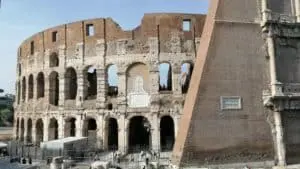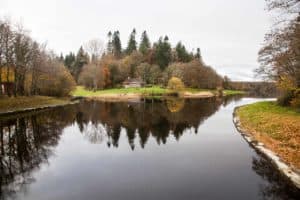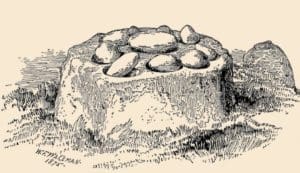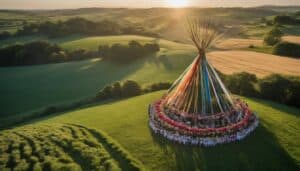In Harmony with Nature: The Revival of Pagan Traditions in Contemporary Irish Culture

Updated On: April 20, 2024 by Yasmin Elwan
In recent years, we’ve observed an intriguing cultural phenomenon in Ireland: the revival of ancient pagan traditions. As a conscious move away from the strictly institutional religious structures, a growing number of people are finding solace and spiritual connection in the rituals and beliefs that predate Christianity. This renaissance of old ways reflects a desire to live in closer harmony with nature and to reconnect with a heritage deeply rooted in Ireland’s past.

Pagan traditions in Ireland are a mosaic of myths, legends, and practices that have been interwoven with the land for millennia. The modern resurgence is not an attempt to revert to bygone times but rather to integrate the wisdom of our ancestors with contemporary life. There’s a rich tapestry of festivals, rituals, and a pantheon of deities that are being revitalised to suit modern sensibilities, all while fostering a profound respect for the natural world.
Historical Overview of Pagan Traditions in Ireland
We discover that the tapestry of Ireland’s spiritual heritage is deeply woven with strands of ancient paganism. Long before Christianity’s tendrils spread across Europe, Ireland was a land steeped in Celtic rituals and druidic practices. The Druids, held in high regard, were the learned class among Celtic societies, presiding over legal matters, educational pursuits, and spiritual affairs.
The island’s pagan past features a rich repertoire of festivals marking significant seasonal transitions. Among the most notable is Samhain, celebrated on the 31st of October, which heralds the arrival of winter. This was not just a fire festival but a time of equilibrium where normal rules were inverted, and even warfare ceased in anticipation of the cold months ahead.
As Christianity began to flourish across Europe, it found its way to Ireland’s shores around the 5th century. Although the island was politically fragmented, the conversion was effected without military force—remarkably, the process integrated or replaced many pagan practices rather than eradicating them. This harmonious fusion resulted in a unique form of Celtic Christianity with its own set of rituals and customs.
In summary, Irish paganism’s repository included nature veneration, celebration of the Celtic New Year, and reverence for natural phenomena. This respect for the natural world still permeates modern Irish culture, reflecting its uninterrupted thread through history. Despite the prevailing Christian influence, traces of the pagan spirit endure in Ireland’s amalgamation of both belief systems.
Modern Paganism and the Neo-Pagan Movement

Within Ireland today, the Neo-Pagan movement has seen a resurgence, reflecting a global trend towards spiritual paths that emphasise personal connection to nature and ancient traditions. This revival represents a nuanced blend of continuity and innovation.
The Pagan Federation and Organisational Structures
The Pagan Federation, established to facilitate the growth of modern paganism, plays a pivotal role in the organisational structure of the neo-pagan community. It serves to connect individuals who identify with various strands of neo-paganism, including Wicca, which is one of the most influential traditions within modern paganism. By offering educational resources, networking opportunities, and events, the federation fosters a sense of unity and provides the framework necessary for the neo-pagan community to thrive and maintain cohesion among modern pagans.
Differences Between Modern Paganism and Historical Practices
Comparing modern paganism with historical practices reveals distinct adaptations. Contemporary paganism takes cues from ancient rituals, but interpretations and implementations have evolved. This difference is particularly evident in practices such as Wicca, which, while inspired by older pagan beliefs, has been subject to modern reinvention. Neo-pagan rituals often incorporate elements pertinent to today’s societal and environmental contexts, symbolising a bridge between past and present, yet not replicating historical rituals in entirety.
Pagan Rituals and Ceremonies Today

In Ireland today, the revival of Pagan traditions is marked by a rich tapestry of rituals and ceremonies that weave nature’s cycles into the lives of those who practise them.
Rituals of the Seasons and Moon Phases
We observe the changing of the seasons through rituals that honour the balance of light and darkness, as well as the phases of the moon, which are deeply rooted in Pagan tradition. The eight major sabbats of the Pagan Wheel of the Year include Samhain, Yule, Imbolc, Ostara, Beltane, Litha, Lammas, and Mabon, each representing a significant turn in the Earth’s cycles.
From moon rituals that align with the new and full moon to mark beginnings and culminations, Pagan practices are synchronised with celestial events. These rites often involve calling upon gods and goddesses to channel divine energy and manifest intentions.
Fire Ceremonies and Dancing Traditions
Fire ceremonies are central to numerous Pagan festivals, symbolising transformation and renewal. Beltane, with its sacred bonfires, is one of these festivals, celebrating fertility and the height of spring. Dancers leap over flames in a gesture of purification and luck, often moving to the rhythm of drums.
Paganism in Ireland also treasures the art of dance within its rituals. Traditional folk dances during celebrations like the Autumn Equinox (Mabon) engage participants with the Earth’s rhythm, strengthening community ties and connecting the physical with the spiritual.
Festivals and Celebrations of the Pagan Calendar
In synchronisation with the natural cycles, our ancestral traditions in Ireland include a rich tapestry of festivals and rites ingrained in the pagan calendar. Chief among these are the celebrations that mark the transitions of spring and winter, hinged on equinoxes and solstices that hold profound significance.
- Spring Equinox (Ostara): Commemorated around 21 March, when day and night are in equilibrium, this is a time of fresh beginnings and fertility. Festivities honour the balance of light and darkness before the days grow longer, heralding the resurgence of life.
- Winter Solstice (Yule): Taking place between 19 and 23 December, this is the longest night of the year. Winter Solstice rituals celebrate the rebirth of the sun and the slow return to warmer days. It’s a deeply reflective period, where the dark gives way to increasing light.
- Autumn Equinox (Mabon): Typically observed from 21 to 24 September, this festival is one of gratitude for the harvest. It mirrors the Spring Equinox with equal day and night, ushering a shift from light to dark.
Table of Festival Highlights:
| Festival | Date Range | Significance |
|---|---|---|
| Ostara | Around 21 March | Spring Equinox: fertility, balance |
| Yule | 19-23 December | Winter Solstice: rebirth, reflection |
| Mabon | 21-24 September | Autumn Equinox: gratitude, transition |
Integral to these celebrations is a profound respect for nature and the belief in the interconnectedness of all life. The revival of these practices in Ireland today manifests in community gatherings, ecological stewardship, and a retracing of our spiritual roots that honour the Earth’s cycles. It is our pathway to connect with the rhythm of nature and to embrace the timeless wisdom of our heritage.
The Role of Nature in Pagan Beliefs
In the practices and spirituality of modern Pagan traditions in Ireland, the natural world holds a place of profound significance. We see nature not merely as a backdrop for human activity but as a sacred sphere infused with divinity and deserving of reverence. This perspective fosters a deep connection between Pagans and the environment, characterising nature as an integral participant in the spiritual experience.
Pagans perceive the Earth as a living entity. The interconnectivity of all life forms is central to our beliefs, promoting a harmonic existence with the natural world. We engage in rituals and celebrations that honour this relationship, often conducting our sacred rites amid the vibrant landscapes that Ireland has to offer.
Cycles of nature — the changing seasons, lunar phases, and life processes — are integral to Pagan worship. We align our practices with these cycles, celebrating the dynamic journey of life, death, and rebirth that they represent. Our rituals mirror these patterns, enriching our spiritual practice and grounding it in the rhythms of nature.
The concept of the Earth as sacred underpins our ethical stance towards environmental conservation. In recognising the Earth as a source of life and spirituality, we accept our responsibility to protect and preserve it. Our efforts to live sustainably are a reflection of our veneration for nature as we strive to minimise human impact on the delicate balance of the ecosystem.
By engaging with the natural world in such a profound way, we, as Pagans, cultivate a spirituality that is rooted in respect and love for the Earth. Through this bond, we find a source of inspiration and a pathway to experiencing the divine, ensuring that our ancient traditions continue to thrive in harmony with the world around us.
Reverence for Deity: Pagan Gods and Goddesses
In Ireland, Pagan traditions have witnessed a revival, where the reverence for the divine takes on profound importance. Goddesses and gods are central to the practices of contemporary Pagans, each symbolising different aspects of life and nature.
One cannot speak of Irish Paganism without acknowledging the Druids. Historically, Druids served as priests and spiritual guides, revered for their wisdom and their intimate relationship with the deities. Today’s Pagan practitioners draw inspiration from this ancient class, with many identifying as neo-Druids, striving to live in harmony with the earth.
The concept of the Great Goddess is pivotal in Pagan worship. She is often celebrated in her triple aspects – maiden, mother, and crone – each representing a stage of the female life cycle and the cycles of nature. This reverence for the feminine divine embodies the respect for fertility, the earth, and sovereignty.
Pagans also pay homage to a pantheon of gods and goddesses from various mythologies, including Celtic, Norse, and Greek. They honour deities such as Brigid, the goddess of healing, poetry, and smithcraft, and Lugh, the god of the sun and of skilled arts. These figures are not just worshipped; they are part of a lifestyle that embraces the sacred in the every day, understanding the divine presence within nature.
Our respect for these traditions is a testament to their resiliency and the continued relevance of ancient wisdom in modern times. By fostering a relationship with these divine figures, we not only connect with our ancestral roots but also with the living spirit of Ireland’s landscape.
Cultural and Religious Syncretism

In exploring the revival of pagan traditions in Ireland today, we must recognise the rich tapestry of cultural and religious syncretism that has woven itself through the history of the British Isles. This blend of beliefs has created a distinctive spiritual landscape where ancient pagan practices are interwoven with more dominant religious traditions such as Christianity, including both Protestant and Catholic denominations.
- Pagan customs, deeply rooted in a reverence for nature, have found expression within traditional Christian festivals. For instance, Celtic Samhain traditions mingle with Christian All Saints’ Day celebrations to form what we now consider Halloween.
- In Scotland, too, we see a harmonious blend where the old and the new coalesce. Celebrations like the fire festival of Up Helly Aa have Viking pagan origins and yet exist alongside the Christian faith widely practised across the region.
- The influence of other world religions, such as Hinduism, has been less pronounced but recognisable in the broader cultural milieu, particularly in the form of holistic practices like yoga and meditation finding their place in Irish culture.
Our cultural heritage is enriched by syncretism, creating a complex and multi-layered spirituality that breathes new life into the ancient traditions of our forebears. In Ireland, this manifests as a revival of pagan traditions that embody a more inclusive and pluralistic approach to spirituality—one that honours the past while adapting to the contemporary fabric of society.
Pagan Traditions and Their Influence on Popular Culture

The revival of Pagan traditions in Ireland today has had a noticeable impact on popular culture. As modern Paganism gains followers, elements of its practices, particularly witchcraft, have seeped into various forms of entertainment and lifestyle.
- Television and Films: Pagan motifs are frequently woven into storylines, with characters who draw upon Pagan practices, embodying both historical and fantastical elements.
- Music and Literature: Themes of Paganism echo in the lyrics of songs and the plots of novels, showcasing its allure and mystical nature.
The Pagan Federation, an organisation supporting Pagans, acknowledges this cultural integration and helps to demystify Pagan practices for the wider public.
| Influence on Popular Culture | Examples |
|---|---|
| Festivals and Celebrations | Pagan-inspired gatherings mirrored in mainstream music and arts festivals. |
| Fashion and Art | Pagan symbols and motifs trend in designs and jewellery, reflecting a fusion of ancient and modern aesthetics. |
| Social Media | Increased online presence of Pagan communities, sharing customs and advocating Pagan-based spirituality. |
By incorporating Pagan themes, popular culture engages with a spirituality that venerates nature and ancient lore. Such inclusivity signals a growing acceptance and curiosity within society, underscoring the enduring relevance of these enchanting traditions.
Pagan Ethics, Morality, and the Worldview
In our exploration of Pagan traditions, it’s imperative to understand how Pagan ethics and morality influence the overall worldview of its practitioners. The core of the Pagan ethos lies in a deep respect for nature, emphasising a harmonious balance between human actions and the natural world.
- Ethics: Pagans often adopt a belief system that is flexible and individualistic. Ethical conduct is guided more by personal responsibility and the understanding of the consequences of one’s actions rather than a prescriptive set of rules.
- Morality: Central to Pagan morality is the ‘sanctity of the other’. Pagans have a profound reverence for life, which extends to people and nature and often includes a polytheistic or pantheistic reverence for deities.
- Worldview: The Pagan worldview is inherently linked with nature and the cycles of the Earth. It is holistic, cyclical, and seasonal, often reflected in the celebration of festivals that mark changes in the year, such as solstices and equinoxes.
- Beliefs and Theology: Theologically, Pagans may hold diverse beliefs ranging from a single divine source to multiple gods and goddesses. These beliefs play a significant role in shaping Pagan ethics, encouraging qualities such as honour, hospitality, and reciprocity.
Our overall approach to understanding Paganism recognises the intricate link between an individual’s actions and the collective existence within the ecosystem. The resurgence of Pagan traditions in Ireland today reflects a desire to reconnect with ancestral wisdom and a worldview that advocates for living in balance with all life forms. Through this lens, Pagans contribute to a more sustainable and ethically conscious society.
Paganism’s Relationship with Other World Religions

Paganism in Ireland, which often manifests in branches such as Wicca and nature religions, maintains a complex relationship with various world religions. Our Catholic Church, with its historical dominance in Ireland, has seen significant interaction with pagan traditions. Embracing the sanctity of nature, Paganism sometimes intersects with Catholicism in the reverence for creation, yet theologically, these paths diverge.
Christianity broadly encompasses a range of perspectives on paganism. While there are tensions, particularly with evangelical branches, some Christians find common ground in the spiritual aspect of nature appreciation. Interfaith dialogues have highlighted shared values, such as the stewardship of the environment.
Moving east, Hinduism shares with paganism a pantheon of deities and philosophical ties to natural cycles. Together, they express a polytheistic appreciation for the divine’s manifestation in natural forms. Collaboration and mutual respect characterise this relationship, as both see divinity resonating in all living things.
Indigenous religions perhaps share the closest affinity with Irish pagan traditions, especially in their animistic beliefs and community rituals tying them to the land. This similarity fosters a kinship based on common practices and worldviews that honour ancestral knowledge and the Earth.
Lastly, the revival of Pagan traditions, including Wicca, places emphasis on the worship of the Goddess and the interconnectedness within nature. Although distinct in practices, Wiccans and adherents of other nature religions often partake in interreligious activities, promoting understanding and celebrating nature’s cycles.
Our relationships with other world religions are characterised by both contrast and commonality. Through respectful interreligious dialogue and shared environmental concerns, we find pathways to mutual understanding and coexistence.
The Future of Paganism in Ireland

In recent years, we’ve seen a resurgence of interest in pagan traditions within Ireland as more individuals seek connections with ancient practices and nature-centric belief systems. Looking ahead, the growth of paganism is likely to continue, buoyed by a global movement towards spiritual diversity and ecological awareness.
The future of paganism in Ireland appears vibrant. As Irish neo-paganism gains traction, we anticipate an increase in the number and diversity of communities that embrace various pagan paths, such as Druidry and Wicca. These communities are fostering evolution in the ways pagan rites and gatherings are organised, making them more accessible to a broader audience.
The organisation of pagan circles is experiencing a shift—moving from closed, secretive groups to more open and welcoming congregations. There is a trend towards formalising groups into structured entities, perhaps even charitable ones, to facilitate growth and provide a cohesive voice for nature-based spirituality.
Moreover, the evolution of pagan networks, including the interweaving of traditional and contemporary practices, is enriching the tapestry of Irish spiritual life. This evolution is becoming increasingly relevant as society grapples with ecological concerns, seeing that paganism often emphasises living in harmony with the Earth.
Lastly, as our community develops, there is a concerted effort to ensure that our values of respect and reverence for nature extend into broader society. By engaging with initiatives around conservation and sustainable living, paganism in Ireland could play an influential role in shaping environmental policy and public attitudes in the years ahead.
Frequently Asked Questions

Exploring the revival of pagan traditions in Ireland today reveals a vibrant tapestry of cultural resurgence and contemporary practice. In this section, we navigate through some of the most common inquiries.
How is paganism currently manifested in Irish society?
Paganism in Ireland now emerges in varied forms, from public celebrations and festivals to private rituals and gatherings. It’s an evolving spiritual path that many Irish people are integrating into their modern lives, often focusing on the reverence of nature and Celtic traditions.
Can you describe the main beliefs and practices of modern Irish pagans?
The core of modern Irish paganism revolves around a connection to the natural world, honouring the cycles of nature, and in many cases, a polytheistic reverence for deities of ancient lore. Rituals and practices vary but commonly include seasonal celebrations and personal rites of passage.
What events marked the resurgence of pagan traditions in Ireland?
The resurgence of pagan traditions in Ireland has been gradual, with increased interest in Celtic spirituality and mythology. Notably, the establishment of Pagan Federation Ireland in 2001 and the growth of online communities have significantly marked this revival.
Which pagan festivals are celebrated in Ireland today?
Pagan festivals, or Sabbats, including Imbolc, Bealtaine, Lughnasadh, and Samhain, are celebrated by modern Irish pagans, coinciding with traditional Celtic festivals that mark the changing seasons.
How do Irish pagan traditions compare with ancient beliefs?
Contemporary Irish pagan traditions often draw inspiration from ancient beliefs, though they’ve adapted to modern contexts. The reverence for Celtic deities, the celebration of festivals, and a deep respect for the earth show continuity with ancient practices.
In what ways do contemporary pagan practices in Ireland reflect environmental concerns?
Today’s Irish pagan practices emphasise environmental stewardship and sustainable living, connecting spiritual practice with ecological responsibility. Rituals often include elements that highlight the importance of living in harmony with nature.






